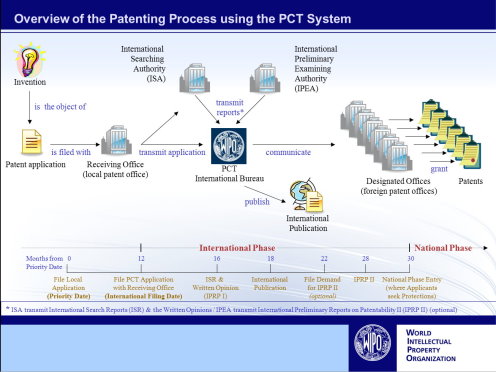Patent Cooperation Treaty Overview
The Patent Cooperation Treaty (PCT) created a unified procedure for filing patent applications that allows Applicants to preserve priority and have the option of
protecting inventions in each of the contracting states.
Accordingly, PCT applications are often called international applications. As of September 24, 2009, there were 142 contracting states to the PCT.
Traditionally, Applicants would file a patent application locally and then file one or more desired foreign applications within 12 months. However, the traditional
approach tends to be rather expensive where multiple foreign patents are desired. Some disadvantages of this approach include:
- Multiple formality requirements;
- Multiple searches;
- Multiple publications;
- Multiple examinations and prosecutions of applications; and
- Translations and national fees are required.
Fortunately, the PCT system alleviates many of the problems associated with the traditional approach. The PCT application does not result in any patent rights itself.
Rather, PCT is a filing system that also provides a search report and written opinion. Generally, the cost of filing a PCT application is somewhere between $3,500 and $5,000,
mostly in government filing fees.
Some of the advantages of the PCT system include:
- One set of formality requirements;
- Delaying costs of filing in member states;
- International search report and written opinion;
- International publication;
- International preliminary examination (if requested); and
- Application may be amended (although this may lead to prosecution history estoppel upon national phase entry).
PCT Applicants must enter the national phase of patent prosecution to obtain protection in desired member countries.
In order to pursue a PCT application, the process is summarized as follows:
(1) Applicants first begin by filing a local patent application.
(2) A single filing of a PCT application is then made with a Receiving Office (RO) within a year of filing the local application, which is a local patent office such
as the USPTO for U.S. entities. The application is then transmitted to the International Search Authority (ISA) and the International Preliminary Examination
Authority (IPEA).
(3) An International search report (ISR) and written opinion (called an International Preliminary Report on Patentability, or IPRP) are generally issued approximately
16 months after the original local application filing date.
(4) The PCT application is published approximately eighteen months after the filing date of the local application.
(5) (Optional) A demand for a second IPRP may be submitted within 22 months of the filing date of the local application.
(6) (Optional) If requested, the second IPRP will be issued approximately 28 months after filing of the local application.
(7) National phase entered for desired states within 30 months of filing of local application.
A helpful visual overview of the PCT process is provided by the World Intellectual Property Organization.

To view the full image from the WIPO presentation, please click
Here.
Additional posts that provide more detail on the PCT process will follow.